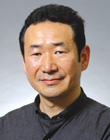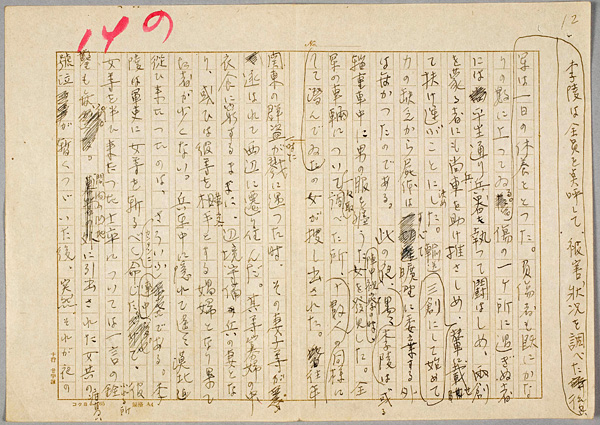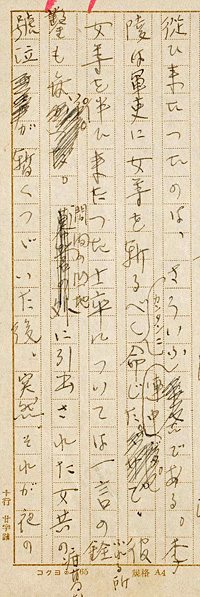Top>Research>Remastering of Atsushi Nakajima’s posthumous manuscripts after 70 years
 Index
Index

Masafumi Yamashita [profile]
Education Course
Remastering of Atsushi Nakajima’s posthumous manuscripts after 70 years
Masafumi Yamashita
Professor of Japanese modern literature, Faculty of Letters, Chuo University
Atsushi Nakajima’s posthumous manuscripts
From summer to autumn in 1942, Atsushi Nakajima had been writing a novel whose main characters were Riryou and Shibasen. The novel features the life of Riryou, who betrayed his country after being defeated by Hsiung-Nu, Shibasen, who was exposed to ridicule by castration, and Sobu, who is admired as the personification of patriotism. However, on December 4th, 1942, Atsushi died from asthma at the young age of 33, leaving 77 manuscripts with enormous amounts of additions and corrections as well as 5 clean copies of the novel’s beginning.
Immediately after Atsushi’s death, his wife Taka entrusted these manuscripts and clean copies to Kyuya Fukada, an older author who had a close relationship with Atsushi. Fukada gave this nameless novel the title of Riryou and made every effort to publish it in the Bungaku-kai. The following year, the novel appeared in the July 1943 issue.

Manuscript (12th page)
Cited from Kanagawa Museum of Modern Literature
All rights reserved
Conventional method of revision

Enlarged portion of the manuscript
Cited from Kanagawa Museum of Modern Literature
All rights reserved
The clean copies were incomplete, the manuscripts contained about 50 unsettled parts and the novel lacked a title. The greatest difficulty lay in the question of how to revise the text and what to name the novel. Although several revisions had been made since the novel’s first appearance, each of the revisions contained some problems.
For example, in the latest Complete Works of Nakajima Atsushi (Chikumashobo Ltd., 2001), a text saying kantanni meijita can be found. Looking at the manuscript, you can see that kantanni was added between the lines of text (4th line from the bottom). It is natural to assume that Atsushi used katakana to write in the narrow space with the intention of replacing it with Chinese characters afterwards. Actually, no other works contain the word kantanni in katakana. --In the first place, authors often write manuscripts in a simple manner using abbreviation of Chinese characters, hiragana and katakana, on the assumption that they will make a clean copy. Of course, there are errors in writing and marks which authors put for reference. In that case, if the manuscripts were to be printed without modification, would it be impossible to publish a novel as Atsushi intended?
The title had been Riryou ever since it was named by Fukada. However, according to two notes left behind by Atsushi, his initial choice for the title was Bakuhoku or Bakuhoku-hika, followed by RiryouShibasen. Bakuhoku refers to the northern part of the Gobi Desert where Riryou fought and was captured by Hsiung-Nu. At the latest, the existence of these notes was already known by 1976 when Complete Works of Nakajima Atsushi was published by Chikumashobo. However, Katsuyoshi Gunji, who compiled the complete works, did not feel the necessity of changing the title despite reading these notes. The editor of the latest complete works also declined to change the title. Although it remains unclear whether Atsushi had decided upon Riryou・Shibasen for the title, I strongly propose that the last title conceived by the author be used.
Remastering
The points explained above left me feeling doubtful about the conventional way of revision. Therefore, based on the supposition that Atsushi had lived long enough to publish this novel in 1943 as scheduled, I decided to revise the text and formulate a title together with Mr. Hideaki Murata (Professor Emeritus at Kumamoto National College of Technology), a leading expert of empirical research regarding Atsushi Nakajima.
In consideration of Atsushi’s intention, the title was changed from Riryou to Riryou・Shibasen. Also, when revising the text, in addition to carefully reading manuscripts and clean copies, we also searched for Atsushi’s writing (unique style of handwriting) in other works and expressions used at that time, scrutinized history books such as Kanjo for the source of the novel, and considered the content of the work. --A process like this can be compared to remastering music. A technician returns to the original sound source, removes noise, adjusts balance in the music and clearly reproduces the performance recorded at that time. We followed a similar process for the text. Of course, strictly speaking, ours was an attempt to remaster non-existent text from the remaining parts of the score (clean copies). Still, 70 years after Atsushi had passed away, we aimed to reproduce text as he would have written.
Unfortunately, as the proverb goes, we soon found that our work was “easier said than done.” The amount of work was enormous and it was the first attempt, so we proceeded by trial and error. At one point, we wanted to give up in the middle of the revision process. Even so, the masterful writing of this novel enabled us to overcome such hardships. Although we had read the text many times, the revision process reaffirmed our understanding that the novel is truly a masterpiece overflowing with appeal, despite the discovery of some defects. We were encouraged to continue our work due to our feeling that the masterpiece deserved to be enjoyed without defects.
Revision for new text
Now, I would like to explain a little about how the text has changed due to our revision.
The first I will address is writing style. Similar to the example of katakana usage introduced above, many manuscripts contain hiragana like shiranai (しらない) and tsuzuku (つヾく). These characters (including okurigana (kana written after a kanji)) were modified according to Atsushi’s writing style after examining his works. A separate case is words such as komekami (こめかみ), which means “temple” (the side of the head behind the eyes). Although the word komekami never appears in Atsushi’s other novels, it is used as an expression in Riryou・Shibasen: komekami wo furuwaseta Butei no kao (こめかみを顫はせた武帝の顔), which means “the face of Butei frowning bitterly.” In this case, Chinese characters (顳顬) are used because komekami is written in a narrow space and Chinese characters with many strokes create a strong visual image of Butei’s angry face. Our work may be criticized as arbitrary, but the same criticism applies to revisers who did not change the hiragana. It is sometimes impossible to judge the correctness of such choices and revisers must make the final decision.
Some parts of the text were changed. One example is the line which once had been read as Kanennen wa sudeni utarete senshi shiteita (韓延年は既に討たれて戦死してゐた), meaning “Kanennen had already been shot and was killed.” Upon carefully reading the manuscript, this line can be interpreted as a direction to edit the text to read Kanennen wa sudeni utarete ita (韓延年は既に討たれてゐた), meaning “Kanennen had already been shot.” This is akin to overly wordy language like umakara ochite rakuba shita (馬から落ちて落馬した), meaning “someone fell off a horse from his mount on the horse.” Therefore, we selected the latter form of succinct language. Conventionally, the part where Shibasen appears is written as tadahitori, niganigashii kao wo shite korera wo mimamotteiru otoko ga ita (唯一人、苦々しい顔をして之等を見守つてゐる男がゐた), meaning “there was a man who was watching them bitterly.” However, in our revision, we adopted the language put in the margin: hitori no otoko ga, tatta hitori no otoko ga, niganigashii kao wo shite korera wo mimamotte ita (一人の男が、たつた一人の男が、苦々しい顔をして之等を見守つてゐた), meaning “a man, only a single man, was watching them bitterly.” We considered this expression to be more dramatic and appropriate for the scene.
We also corrected errors in the text resulting from Atsushi’s lapse of memory. One example is the part reading “Rikan (second son of Rikou).” Based on the Kanjo and notes developed by Atsushi, this part was altered into “Rikan (third son of Rikou).”
We also reviewed symbols which had not been given sufficient consideration in previous revisions. For example, a wavy line alongside hotobori (ほとぼり) is changed into dots in the new complete works. However, the wavy line cannot be seen as dots and it is not necessary to add dots to this section. Therefore, following writing rules at that time, hotobori is converted to yonetsu (余熱) based on the assumption that Atsushi used the wavy line to designate Chinese characters which he could not remember and wanted to check later.
We also discovered content which required correction. For example, there is a line saying hoko wo hiita Riryou wa (戈を引いた李陵は), meaning “Riryou drew back his dagger-axe.” This line comes two lines after the one stating kare ha geki wo torinaosuto (彼は戟を取直すと), meaning “he changed his grip on his halberd.” It is unnatural for Riryou to draw back a dagger-axe when he entered into the battle with a halberd. As a halberd and a dagger-axe are different from each other, hoko (戈), or dagger-axe, was replaced with geki (戟), or halberd, to avoid confusion.
Finally, I would like to mention the character style. In principle, characters had to be written orthographically at that time. However, in Atsushi’s novel, some Chinese characters were written without following the rules of orthography (there is also the problem of defining the correct rules for orthography). In this revision, in order to reproduce as much as possible the character style used at that time, we followed the style in the Bungaku-kai where this novel made its first appearance. One example is the character hei (並). Although the orthographical form for hei was “竝,” the character is written as “並” in the Bungaku-kai and other of Atsushi’s published works.
*
Thanks to this remastering, Riryou・Shibasen has been made more readable. In 2012, 70 years after Atsushi’s death, the novel was published as Riryou・Shibasen by Atsushi Nakajima in cooperation with the Kanagawa Museum of Modern Literature, which houses related materials. A set of two volumes is available. One is an illustrated volume showing clean copies, manuscripts and notes related to this novel. The other is a standard volume containing reproduced text as it would have been published, corrections and annotations, and text in which characters are converted into modern written Japanese with more yomigana (kana indicating the pronunciation of kanji) and notes.
I recommend that you first read the part written in modern Japanese. Then, by following Atsushi’s thoughts while looking at the photographs, I hope you can enjoy the clear and well-written reproduced text as it would have been published. I hope that many readers will enjoy this wonderful work.
Site of organization owning materials: Kanagawa Museum of Modern Literature http://www.kanabun.or.jp/![]()
- Masafumi Yamashita
Professor of Japanese modern literature, Faculty of Letters, Chuo University - Born in 1960 and from Hokkaido. Graduated from University of Tokyo Faculty of Letters in 1984. Dropped out of University of Tokyo Graduate School of Humanities in 1990. The same year, became an Assistant at University of Tokyo Faculty of Letters. Assumed his current position in 2003 after a Full-Time Lecturer at Shirayuri College in 1993 and an Assistant Professor of the same college. Centered on Atsushi Nakajima, his research is focused on studying literature in Showa era historically when modern literature changed greatly. His major publications include Atsushi Nakajima to Sono Jidai (Atsushi Nakajima and the Era), (Soubunshashuppan, 2009) etc.
- Research Activities as a Member of Research Fellowship for Young Scientists (DC1), Japan Society for the Promotion of Science (JSPS) Shuma Tsurumi
- Important Factors for Innovation in Payment Services Nobuhiko Sugiura
- Beyond the Concepts of Fellow Citizens and Foreigners— To Achieve SDGs Goal 10 “Reduce Inequality Within and Among Countries” Rika Lee
- Diary of Struggles in Cambodia Fumie Fukuoka
- How Can We Measure Learning Ability?
—Analysis of a Competency Self-Assessment Questionnaire— Yu Saito / Yoko Neha - The Making of the Movie Kirakira Megane








